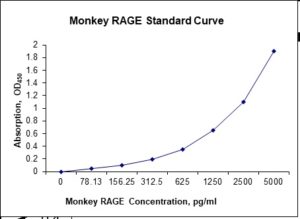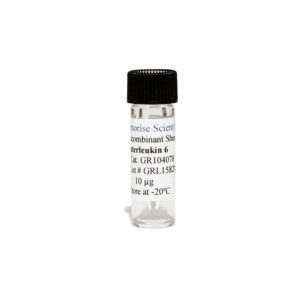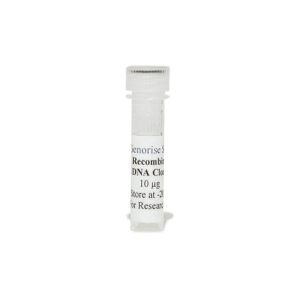Nori Monkey RAGE ELISA Kit
$461.00 – $832.00
This ELISA kit is for quantification of RAGE in monkey. This is a quick ELISA assay that reduces time to 50% compared to the conventional method, and the entire assay only takes 3 hours. This assay employs the quantitative sandwich enzyme immunoassay technique and uses biotin-streptavidin chemistry to improve the performance of the assays. An antibody specific for RAGE has been pre-coated onto a microplate. Standards and samples are pipetted into the wells and any RAGE present is bound by the immobilized antibody. After washing away any unbound substances, a detection antibody specific for RAGE is added to the wells. Following wash to remove any unbound antibody reagent, a detection reagent is added. After intensive wash a substrate solution is added to the wells and color develops in proportion to the amount of RAGE bound in the initial step. The color development is stopped, and the intensity of the color is measured.
Alternative names for RAGE: Receptor for advanced glycation endproducts), AGER
This product is for Laboratory Research Use Only not for diagnostic and therapeutic purposes or any other purposes.
- Description
- How Elisa Works
- Product Citation (0)
- Reviews (0)
Description
Nori Monkey RAGE ELISA Kit Summary
Alternative names for RAGE: Receptor for advanced glycation endproducts), AGER
Alternative names for monkey: various species of monkey
| Assay Type | Solid Phase Sandwich ELISA |
| Format | 96-well Microplate or 96-Well Strip Microplate |
| Method of Detection | Colorimetric |
| Number of Targets Detected | 1 |
| Target Antigen Accession Number | na |
| Assay Length | 3 hours |
| Quantitative/Semiquantitative | Quantitative |
| Sample Type | Plasma, Serum, Cell Culture, Urine, Cell/Tissue Lysates, Synovial Fluid, BAL, |
| Recommended Sample Dilution (Plasma/Serum) | No dilution for sample <ULOQ; sufficient dilution for samples >ULOQ |
| Sensitivity | 15 pg/mL |
| Detection Range | 78-5000 pg/mL |
| Specificity | Monkey RAGE |
| Cross-Reactivity | < 0.5% cross-reactivity observed with available related molecules, < 50% cross-species reactivity observed with species tested. |
| Interference | No significant interference observed with available related molecules |
| Storage/Stability | 4 ºC for up to 6 months |
| Usage | For Laboratory Research Use Only. Not for diagnostic or therapeutic use. |
| Additional Notes | The kit allows for use in multiple experiments. |
Standard Curve
Kit Components
1. Pre-coated 96-well Microplate
2. Biotinylated Detection Antibody
3. Streptavidin-HRP Conjugate
4. Lyophilized Standards
5. TMB One-Step Substrate
6. Stop Solution
7. 20 x PBS
8. Assay Buffer
Other Materials Required but not Provided:
1. Microplate Reader capable of measuring absorption at 450 nm
2. Log-log graph paper or computer and software for ELISA data analysis
3. Precision pipettes (1-1000 µl)
4. Multi-channel pipettes (300 µl)
5. Distilled or deionized water
Protocol Outline
1. Prepare all reagents, samples and standards as instructed in the datasheet.
2. Add 100 µl of Standard or samples to each well and incubate 1 h at RT.
3. Add 100 µl of Working Detection Antibody to each well and incubate 1 h at RT.
4. Add 100 µl of Working Streptavidin-HRP to each well and incubate 20 min at RT.
5. Add 100 µl of Substrate to each well and incubate 5-30 min at RT.
6. Add 50 µl of Stop Solution to each well and read at 450 nm immediately.
Background:
RAGE (receptor for advanced glycation endproducts), also called AGER, is a 35 kilodalton transmembrane receptor of the immunoglobulin super family which was first characterized in 1992 by Neeper et al.[1] The interaction between RAGE and its ligands is thought to result in pro-inflammatory gene activation.[2] [3] Due to an enhanced level of RAGE ligands in diabetes or other chronic disorders, this receptor may have a causative effect in a range of inflammatory diseases such as diabetic complications, Alzheimer’s disease and even some tumors. Isoforms of the RAGE protein, which lack the transmembrane and the signaling domain (commonly referred to as soluble RAGE or sRAGE) may counteract the detrimental action of the full-length receptor. RAGE has been linked to several chronic diseases, which are thought to result from vascular damage. RAGE itself is upregulated by NF-κB. Given a condition in which there is a large amount of RAGE ligands (e.g. AGE in diabetes or amyloid-β-protein in Alzheimer’s disease) this establishes a positive feed-back cycle, which leads to chronic inflammation. This chronic condition is then believed to alter the micro- and macrovasculature, resulting in organ damage or even organ failure.[4] RAGE is expressed at the highest levels in the lung compared to other tissues, in particular in alveolar epithelial type I cells, and is lost in Idiopathic pulmonary fibrosis indicating that expression and regulation of RAGE in the pulmonary system differs from that in the vascular system. Blockade/knockdown of RAGE resulted in impaired cell adhesion, and increased cell proliferation and migration[5]
References
- Neeper M, et al. (1992). The Journal of Biological Chemistry. 267 (21): 14998–5004.
- Bierhaus A, et al. (2001). Diabetes. 50 (12): 2792–808.
- Gasparotto, J; et al. (2017). J Biol Chem. 293: 226–244.
- Gasparotto, J; et al. (2019). Mol Neurobiol. 56(5): 3079–3089.
- Queisser MA, (2008). American J Respiratory Cell and Molecular Biology. 39 (3): 337–45.
Be the first to review “Nori Monkey RAGE ELISA Kit”
You must be logged in to post a review.































Reviews
There are no reviews yet.